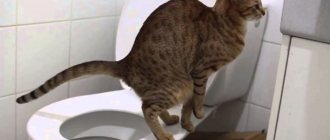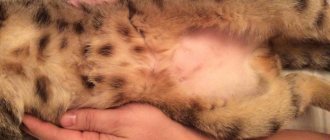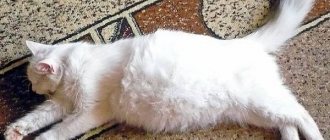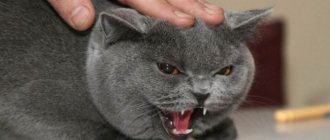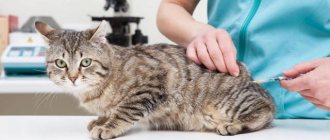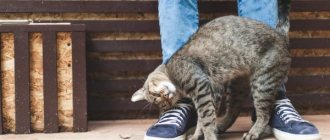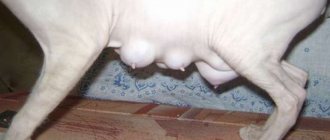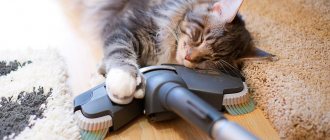9279Pavel
When a cat has a hard stomach, it is necessary to urgently take the animal to a veterinarian. Delay in treatment can lead to the death of your pet. If there is a hard lump in the stomach, then this is also a reason to visit a specialist. The phenomenon may indicate the presence of a tumor or intestinal blockage. Both are extremely dangerous.
Hardness causes tension in the abdominal muscles, which is unnatural. Very often, in addition to this, the cat experiences bloating and other gastrointestinal disorders.
© shutterstock
Why does deviation occur?
The development of the deviation is influenced by pathological and physiological factors. The first are dangerous to health and require the intervention of a veterinarian. The latter are natural, so they are easy to figure out on your own.
Hazardous factors
The presence of pathology is indicated when the abdominal muscles do not relax for more than a day, and the pet’s condition gradually worsens.
This is due to the following reasons:
- Constipation
. It occurs due to intestinal spasms, improper feeding, ingestion of a foreign object, helminthiasis and the accumulation of hair in the intestines during heavy shedding. Without prompt treatment, constipation can lead to intestinal obstruction and death. - Peritonitis
. The peritoneal mucosa becomes inflamed upon contact with gastric or intestinal contents. The penetration of foreign microflora is fraught with epithelial detachment and necrosis. - Poisoning
. Against the background of acute intoxication, painful spasms occur in the lower part of the stomach. - Abscess
. The danger of purulent formation in the abdominal organs lies in its rupture and subsequent blood poisoning. - Trauma
. When internal organs are damaged, their contents leak into the peritoneum. The further reaction is similar to peritonitis. - Cholecystitis (biliary colic)
. Inflammation of the gallbladder occurs when there is excessive production of bile or the formation of stones. The patient's peritoneum hardens and excruciating pain occurs. - Pyometra
. Purulent inflammation in the uterus appears with frequent mating, hormonal disorders and infections. - Ascites (abdominal dropsy)
. With this disease, free fluid accumulates in the abdominal cavity. Most often this occurs as a result of poor circulation. - Neoplasms
. The growth of the tumor is reflected in the size of the peritoneum. Most often, neoplasms occur in older animals. - Panleukopenia (distemper)
. Infection with the virus occurs in utero, during a bite by a blood-sucking insect, or through contact with an infected animal or its biological fluids.
All these causes can be eliminated with medication. Without timely help, even simple constipation becomes dangerous.
Non-hazardous factors
An enlarged and dense belly in a cat also appears for natural reasons.
These include:
- Flatulence
. A tight stomach appears when there is an excess accumulation of digestive gases. Usually this condition goes away with dietary adjustments, but sometimes it is a sign of helminthiasis, dysbacteriosis, intestinal obstruction and other diseases. - Pregnancy
. Shortly before childbirth, the size of the uterus increases greatly. The abdominal muscles become harder to protect the kittens inside the womb. The condition returns to normal a few hours after the birth of the offspring. - Stress
. By tensing the abdominal muscles, the pet tries to protect itself from the source of fear or unpleasant touches. This behavior is typical for animals that have suffered physical abuse. - Obesity
. If the pet is neutered and inactive, then it quickly gains weight. This situation can be easily managed with diet and increased activity. Remember that the lack of response threatens premature death from fatty degeneration of the myocardium, that is, obesity of the heart.
Associated symptoms will help distinguish pathological factors from physiological ones. If they are detected, you must immediately contact a veterinary clinic.
Normal or pathological?
A pet's stomach that is too hard is not normal. Only cases when the animal is frightened can be considered the norm. At the same time, the cat deliberately tenses his abdominal muscles to protect the vulnerable area.
This behavior is typical for animals that have previously been abused by people. This is usually encountered by owners of kittens recently taken from the street. No specific treatment is required, since a hard abdomen in this case acts as a protective reaction and not a symptom of the disease. The problem will be solved over time, when the animal gets used to the house and ceases to be afraid of people.
In all other cases, hard abdominal muscles are a reason to consult a veterinarian. In this case, the behavior of the pet is of great importance. If swelling and hardness of the muscles are accompanied by a loss of strength and difficulty defecating, the cat must be urgently hospitalized.
Symptoms indicating illness
In addition to the duration of the bloating, it is important to consider any warning signs. Possible pathology is indicated by:
- inflammation, yellowing or blue discoloration of mucous membranes;
- too rapid enlargement of the peritoneum or sudden weight loss;
- frequent vomiting, diarrhea, or lack of bowel movements for more than 2 days in a row;
- lethargy and fever;
- pain when emptying the bowel or bladder;
- dullness and hair loss;
- foam, blood or parasites found in vomit and feces;
- increased thirst and loss of appetite;
- profuse drooling;
- severe pain in the abdominal area upon palpation.
If a pregnant cat's swollen belly does not return to normal within 1.5 days after birth, call a veterinarian. This condition is typical for unfinished labor. The stuck fetus will have to be removed surgically.
Changes in muscle tone during pregnancy
In most cases, pregnancy in cats is easy. The cat does not feel any discomfort, but is reluctant to be handled and strains its abdominal muscles when trying to feel it. A very hard belly in a cat may indicate a pathologically developing pregnancy. This condition ends in miscarriage and is accompanied by changes in the pet’s behavior - she refuses to eat, drinks a lot, behaves restlessly and constantly meows. In the early stages, detecting a miscarriage in a cat is problematic, while pregnancy failure in the later stages is accompanied by heavy bleeding.
Bloating in kittens
When purchasing a kitten, always inspect its tummy. In a healthy animal it should be soft and small. A temporary increase may occur after a recent feeding or shortly before going to the toilet.
If a healthy baby's tummy becomes the size of a balloon or a pear, be sure to worm your pet and take him to the vet. Anti-parasite tablets are given at intervals of 2 weeks. At the first ingestion, all adult individuals die, and at the second, the remaining eggs, which have evolved into adult worms, die.
How contractions begin before childbirth
What is a woman who is preparing to become a mother for the first time afraid of? The answer is obvious: contractions. After all, the anticipation of pain causes greater fear in a pregnant woman than the pain itself. The closer the finish line, the more obsessively this fear haunts the woman. But if a woman is psychologically prepared, it is easier for her to overcome it. So, in order not to be afraid, you need to understand how contractions begin and what to expect from them.
How contractions begin
Before giving birth, the woman's placenta and the baby's pituitary gland begin to produce special substances (in particular the hormone oxytocin and prostaglandins), which cause contractions of the mother's uterus, called contractions. Birth pains
- these are involuntary and regular contractions of the uterus in a woman in labor, which are accompanied by a nagging, palpable pain in the lower abdomen and lower back.
During pregnancy, a woman's cervix is tightly closed. As soon as contractions begin before childbirth, its opening begins: the cervix of the uterus gradually smoothes out and expands in diameter to 10–12 cm. During contractions, intrauterine pressure increases, as the uterus contracts in its volume. As a result, this leads to the fact that the amniotic sac ruptures and amniotic fluid flows out. The first stage of labor (preparatory) lasts approximately 12 hours if this is the woman’s first birth.
How do you know when real contractions are starting?
Women in labor who are expecting their first baby worry that they will not be able to determine the onset of the contractions themselves. Primiparas may confuse prenatal contractions with preliminary training contractions. How to distinguish them? Preliminary contractions before childbirth are not regular, such contractions do not become more frequent or intensified, and they are not as intense as during childbirth.
Regular contractions indicate the onset of labor. The onset of contractions, for example, is characterized by the fact that the contraction lasts forty seconds, after which there is a twenty-minute break, then again the contraction lasts forty seconds, after which there is a fifteen-minute break, then again there is a forty-second contraction and a fifteen-minute break. During contractions, sensations are very individual. Sometimes the first pain is felt in the lumbar region, and then spreads to the stomach, which hardens with each contraction.
What should a woman in labor do during contractions before giving birth?
The woman in labor should not be tense and afraid; she needs to breathe deeply and slowly, and she can even sing. After all, proper breathing is very important. since the baby will be able to receive enough oxygen, and the mother’s body will be able to relax. After the contraction begins, the woman in labor needs to completely relax her body and breathe shallowly (take quick and rhythmic inhalations and exhalations). And when the contraction has passed, then you can take a full breath with your stomach and chest, then exhale slowly. Pain syndrome can be relieved by massage of the lower back and sacrum.
When should you go to the maternity hospital?
It is imperative to remember that the process of childbirth has just begun and contractions will gradually become more frequent, prolonged and intense, so going to the maternity hospital at the first contractions is pointless. When the interval between them is five minutes and their duration is one minute, then call an ambulance or a taxi.
Diagnostics and therapy
To make a diagnosis, blood, urine and feces are examined, ultrasound and x-rays are done. During the examination, the veterinarian palpates and listens to the peritoneum. Depending on the results that explain why the cat has a hard stomach, the doctor decides what to do to normalize his condition.
Help with non-dangerous causes of bloating
Flatulence caused by poor nutrition can be eliminated by adjusting the diet. A ban is imposed on any products that increase gas formation (legumes, flour, fresh vegetables). Remember that milk is contraindicated for adult animals, as they develop lactose intolerance. To normalize intestinal function, your veterinarian may recommend a course of probiotics.
Excessive weight can be eliminated by reviewing your diet. The animal is prescribed less high-calorie food and the usual portions are reduced. Daily physical activity is complemented by joint games.
A big belly in a scared cat can be healed with time. Do not impose your affection and let your pet get used to the unfamiliar environment.
Treatment of the underlying disease
Surgery will be required to eliminate pyometra. During the operation, the veterinarian cuts out the uterus, that is, performs sterilization. Surgeries are also necessary to remove a tumor, intestinal obstruction, foreign object, or the consequences of severe trauma.
All infectious diseases are treated with antibiotics and antiviral drugs, and helminthiasis with anthelmintics. Intoxication with poisons is eliminated by administering an antidote and gastric lavage. In case of ascites, excess fluid is pumped out of the animal and a course of diuretics is prescribed.
To treat constipation, use Vaseline oil or laxatives. Such therapy is permissible only in the absence of intestinal obstruction. Otherwise, taking these drugs may cause intestinal rupture.
Treatment for an abscess depends on its complexity. Most often, drug therapy, which involves taking antibiotics and anti-inflammatory drugs, is sufficient. In case of extensive inflammation, the ulcers are removed by a surgeon.
Cholecystitis is treated with antibiotics and proper nutrition. The animal is transferred to a veterinary food that fights gallstones.
Any therapy must be carried out under the supervision of a veterinarian, with dosages clearly specified by him.
Treatment
Treatment can be conservative or surgical. This will depend on the cause of the hard belly syndrome. For example, in case of helminthic infestation, it will be necessary to carry out specific antiparasitic therapy; in case of constipation, a special diet and mild laxatives will be required. Antispasmodics are often recommended as symptomatic therapy. These remedies help relax the muscles of the abdominal wall, but can neutralize many symptoms and complicate diagnosis. Therefore, it is better for the veterinarian to show the animal before trying to help it. The most competent method of first aid would be to provide the animal with rest and deliver it to a veterinary hospital.
How to protect your cat from abdominal problems
Pathological bloating can be avoided by following preventive measures. To protect your furry pet you must:
- Control your diet and mobility. Follow the recommended guidelines and maintain daily activity.
- Prevent contact with street animals. Try not to take your cat outside and be sure to vaccinate him against common infections.
- Install “anti-cats”. Protection on the windows will prevent injury from a fall.
- Treat for parasites every quarter.
- Resort to sterilization if there are no plans to breed the breed. Sterilized animals reduce the risk of developing cancer and pyometra.
- Also, do not forget about an annual visit to the veterinarian for preventive purposes. If your pet has a chronic illness, increase the number of visits to twice a year.
A hard and swollen abdomen does not always indicate pathology, but still suggests a response from the owner. Due to the large number of possible pathological factors, visiting a veterinary clinic is the only reliable way to diagnose and prevent dangerous consequences.
Sources:
https://kinpet.ru/nuzhno-li-bespokoitsya-esli-u-kota-tverdyy-i-vzdutyy-zhivot/
https://usatiki.ru/plotnyj-zhivot-u-koshki-prichiny-i-chto-delat/
https://koshkamurka.ru/7847-pochemu-u-kota-tvyordyj-zhivot.html
